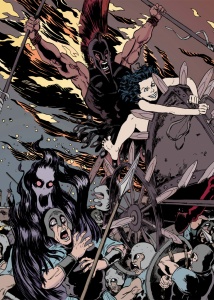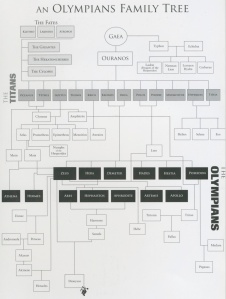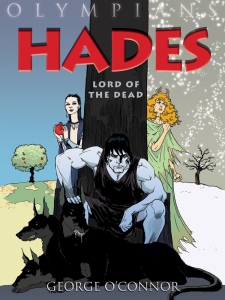I just returned from a great Literacy Research Association (LRA) conference held on Marco Island, FL. Like many in my field I have few colleagues in my sub-sub-sub field (graphic novel reading) and LRA gives me a change to catch up on everything. It leaves me exhausted and invigorated.
So, I came into the office – it is something like 19 degrees outside and 87 degrees inside – ready to grade papers, talk to students,  and change my syllabus for next semester’s children’s and YA literature course to reflect the research I saw at LRA. But, before all that started, I found the latest in George O’Connor’s Olympians series in my mailbox!!!
and change my syllabus for next semester’s children’s and YA literature course to reflect the research I saw at LRA. But, before all that started, I found the latest in George O’Connor’s Olympians series in my mailbox!!!
Like so many graphic novel readers I have loved this series since Zeus (Vol. 1) but truth be told Hades (Vol. 4) was by far my favorite and remains so today.
Ares: Bringer of War is another solid edition to the series. The color red runs throughout the book, beginning with the cover. In this book O’Connor does some interesting work delineating Ares and Athena early on. Athena (Vol. 2) is given a cool shade of blue-gray as her color and it reflects her appreciation for strategy as a way to enter into war with a clear and levelheaded strategy. She is not swayed by passion or emotion, or so she would have us believe.

Ares on the other hand is the epitome of passion and madness of battle. The image of Ares and his sister Eris plunging into war provide a beautifully disturbing starting point for the story. The blue gray calm of the bottom left portion of the page is ravaged by Ares and Eris’s flaming chariot as it rips through the troops. The soldiers fear and confusion is apparent as their wide, white eyes that stand in shocked contrast to the rest of the page.
Ares: Bringer of War highlights the connections between the Olympian gods and the Trojan War. First as a comparison between Athena and Ares, then as a stage for the continued competition between Hara, Aphrodite and Athena (see Aphrodite: Goddess of Love). After all, it was the competition between these three which began the Trojan war in the first place!
And so it is with this volume that O’Connor provides us with another view of the gods and the whimsy they took with human life. The treatment O’Connor gives to Hara, Aphrodite and Athena is oneof the most interesting aspects of this book. Each one takes a champion in the war to represent their godly interests with no regard for the mortal himself. O’Connor provides a visual of the ways champions were mere puppets for the gods: Athena looming like a large shadow over Diomedes as she takes him into battle against Ares, and Hara feeding words of encouragement to her army through Stentor as she stands behind him.
Ares, like many of the gods of Olympus, lost a son in the battle for Troy, but unlike the other gods he truly grieves the loss. His grief becomes the catalyst for a short lived brawl between the gods, but the war rages on between the mortals well after the gods have lost interest.
The lively images and playful treatment of some of the gods makes it a fun and exciting read. But as a retelling of the Iliad it lacks the coherence I have come to expect from O’Connor. Because he dips in and out of the traditional story, this volume might be confusing for readers who don’t know the Iliad, or the divisions between the the Greeks and the Trojans. Given the shortcomings of the text, I think this volume would be a great supplement Homer’s Iliad.
The battle of troy rages on even after the gods loose interest, except for Zeus and Ares. They remain to the bitter end. Ares understands his own nature, and in the end he realizes he is much like Zeus, his father. And this realization brings no relief to Ares or, as it turns out, to man.





